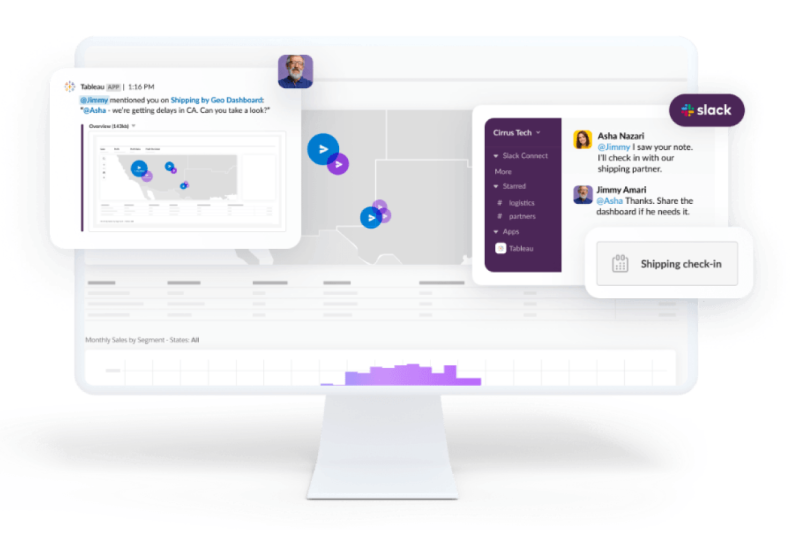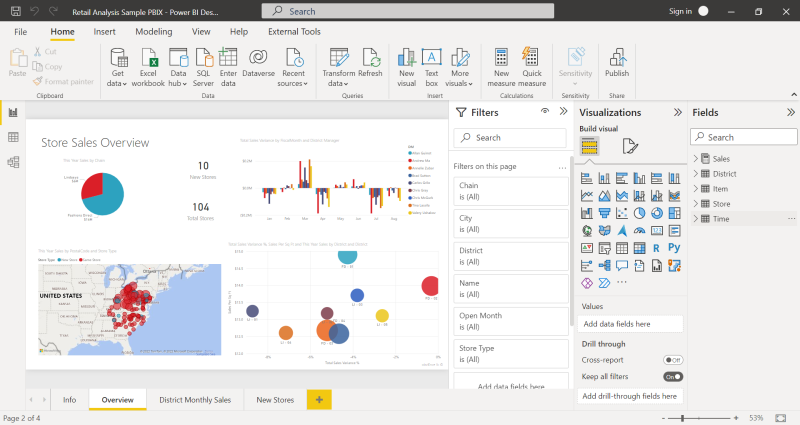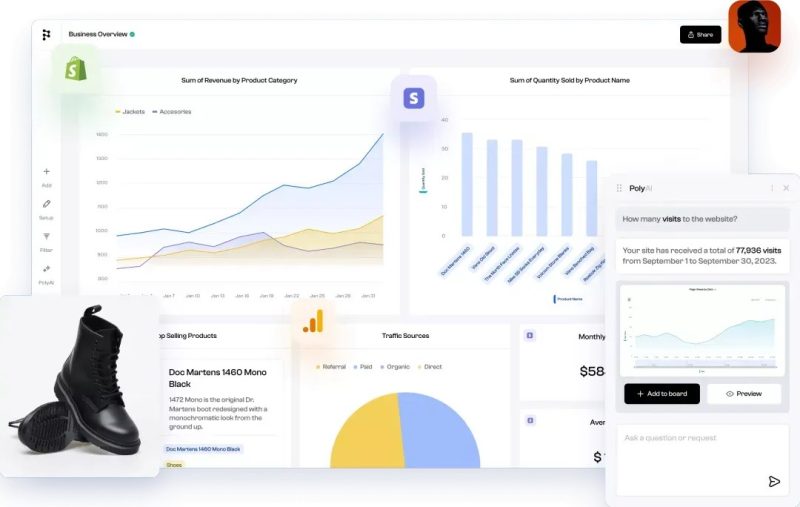AI tools for data analysis - table of contents
How does AI transform data analysis into knowledge?
Big Data refers to large and complex datasets that are difficult to manage by humans. This is where AI comes in with solutions that not only handle their volume but also facilitate the extraction, processing, and analysis of information.
For example, an AI data analysis tool such as ChatGPT Plus with an attached document analysis module can analyze customer data and create personalized marketing messages based on that data, helping to improve campaign effectiveness. Platforms like Tableau, on the other hand, use AI to create advanced data visualizations that help identify trends that may be relevant to product or service development.
In the context of converting data into knowledge, AI enables:
- predictive modeling – AI can make predictions, analyze potential scenarios, and determine the most favorable outcomes,
- segmentation analysis – thanks to artificial intelligence, it is possible to precisely identify target groups, which significantly affects the effectiveness of marketing campaigns,
- data cleaning – the best AI tools for data analysis automatically identify and correct data errors, saving the analyst’s time,
- data visualization – tools like Power BI allow for creating interactive charts and reports, making it easier to understand trends.
Using these top AI tools, companies can make better business decisions based on solid data analysis.
Key benefits of using AI in data analysis
Automation and predictive data analysis are the two main benefits of using AI. Automation frees analysts from repetitive tasks, allowing them to focus on strategy. AI has no human bias and can process data at incredible speed, predicting campaign results and providing proactive insights.
The benefits of using AI in data analysis are primarily:
- saving time and resources, which can be used for strategic analysis and taking appropriate action,
- standardization of data analysis, which enables tracking data without the need for acquiring specialized skills in data processing and analysis,
- minimizing errors in data analysis by directly uploading files to the tool, making data analysis more reliable.
Top AI tools for data analysis
Choosing the right AI tool for data analysis can significantly impact the success of a business. Here is an overview of the best AI tools available on the market.
ChatGPT Plus
The best-known powerful AI language model developed by OpenAI, can:
- generate text and images,
- analyze data, and
- answer questions in natural written and spoken language.
In the paid version available in Plus, Team, and Enterprise plans, it can be used for automating reports or creating analytical scripts for data transformation in Python or R, using natural language commands.
Thanks to the ability to attach files to the prompt in ChatGPT, we can easily “talk to data”, which makes it one of the best AI tools. Its precision in following user instructions is a key advantage, while a drawback is the need to prepare data for analysis using other software.
However, ChatGPT is able to handle:
- repeated lines,
- missing data,
- unit inconsistencies,
- identifying outliers,
- error checking, and also
- cleaning, preprocessing, analyzing, and visualizing data.
AI works well with structured data. You can upload Excel or CSV files and instruct ChatGPT to describe, process, analyze, visualize, and interpret the data.
Tableau
Tableau is a platform for data analysis and visualization. It enables easy interpretation of complex datasets. Thanks to its intuitive interface, users can create advanced dashboards without the need for programming skills.
Tableau has an “Ask Data” feature that allows users to formulate queries in natural language and then automatically creates appropriate data visualizations. This feature uses artificial intelligence to interpret a user’s query and provide a data-driven answer. Tableau also offers other AI-based features, such as “Explain Data,” which automatically performs data analysis and provides valuable insights.

Source: Tableau (https://www.tableau.com/)
Power BI
Power BI is a Microsoft product that integrates AI to deliver deep analysis and data visualization. It has AI-based features such as AI Insights that allow users to discover hidden patterns and relationships in data.
Power BI provides a comprehensive set of AI-based tools to efficiently and easily enrich data using pre-built or custom machine learning models. Artificial Intelligence in Microsoft Power BI, known as AI Insights, enables:
- emotion analysis in the text,
- extraction of key words and phrases,
- language identification, and
- recognition of proper nouns.
It is used to analyze customer reviews, automatically detect key themes in product reviews, recognize the language of emails, and identify the names of people, organizations, and places in newspaper articles. Power BI also allows you to work with images, including automatically tagging images and classifying them with labels that describe their content. It is used to categorize product images, tag landscapes or animal photos, recognize faces or logos, and create scene descriptions on images. What’s more, Power BI is integrated with Azure, giving you access to advanced analytical models and cloud capabilities.

Source: Microsoft Power BI (https://powerbi.microsoft.com/)
Microsoft Excel
The second Microsoft tool that is great for data analysis is Excel powered by Microsoft 365 Copilot. This suite is one of the best AI tools available, with capabilities for creating visualizations and data queries using natural language. Excel powered by AI is available to Microsoft 365 subscribers, starting at $99 per year.
Polymer
Polymer is an intelligent data analysis solution (BI) that doesn’t require complex configuration or a steep learning curve. It allows you to create visualizations, build dashboards and present data in minutes. Here are its key features and benefits:
- easy data integration — Polymer allows for easy transfer of datasets to initiate their exploration and visualization. No technical skills are needed.
- insight automation — this great tool uses artificial intelligence to automatically generate insights from data, such as trends, patterns, anomalies and forecasts. Users can also ask questions in natural language and receive answers in the form of charts and tables,
Importantly, if you’re not convinced, Polymer offers a free 14-day trial. Pricing plans start at $9 per month per user. Its developers also made sure that visualizations and dashboards can be easily shared and commented on, as well as exported and embedded in web pages or presentations.

Source: Polymer (https://www.polymersearch.com/)
Which areas of the business benefit most from data analysis
Various business sectors can leverage data analysis to gain a competitive advantage and better understand the market and customers. Here are a few examples:
- Predicting market trends through AI – tools such as ChatGPT can assist small businesses in forecasting trends, which is crucial for their development and adaptation to changing market conditions.
- AI in competitive analysis – AI tools can be used to analyze the competitors’ actions, allowing you to optimize your own business strategy.
- Understanding the customer – segmentation and AI data analytics help analyze large data sets, which is especially useful for small businesses with limited resources. For example, Polymer automatically segments customers based on their online activity.
- Automatic report generation – saves time and resources by automating the reporting process, which allows businesses to focus on other key areas of the business. For example, Microsoft Excel can automatically generate sales reports based on data from the CRM system.
Summary
By using the best AI tools for data analysis, companies can not only increase efficiency but also discover new business opportunities and better understand their customers. All of this translates into better decisions and a stronger position in the market. Introducing AI into the analytics process is a step that can bring tangible benefits to businesses and help them achieve long-term success.

If you like our content, join our busy bees community on Facebook, Twitter, LinkedIn, Instagram, YouTube, Pinterest, TikTok.
Author: Robert Whitney
JavaScript expert and instructor who coaches IT departments. His main goal is to up-level team productivity by teaching others how to effectively cooperate while coding.
AI in business:
- Threats and opportunities of AI in business (part 1)
- Threats and opportunities of AI in business (part 2)
- AI applications in business - overview
- AI-assisted text chatbots
- Business NLP today and tomorrow
- The role of AI in business decision-making
- Scheduling social media posts. How can AI help?
- Automated social media posts
- New services and products operating with AI
- What are the weaknesses of my business idea? A brainstorming session with ChatGPT
- Using ChatGPT in business
- Synthetic actors. Top 3 AI video generators
- 3 useful AI graphic design tools. Generative AI in business
- 3 awesome AI writers you must try out today
- Exploring the power of AI in music creation
- Navigating new business opportunities with ChatGPT-4
- AI tools for the manager
- 6 awesome ChatGTP plugins that will make your life easier
- 3 grafików AI. Generatywna sztuczna inteligencja dla biznesu
- What is the future of AI according to McKinsey Global Institute?
- Artificial intelligence in business - Introduction
- What is NLP, or natural language processing in business
- Automatic document processing
- Google Translate vs DeepL. 5 applications of machine translation for business
- The operation and business applications of voicebots
- Virtual assistant technology, or how to talk to AI?
- What is Business Intelligence?
- Will artificial intelligence replace business analysts?
- How can artificial intelligence help with BPM?
- AI and social media – what do they say about us?
- Artificial intelligence in content management
- Creative AI of today and tomorrow
- Multimodal AI and its applications in business
- New interactions. How is AI changing the way we operate devices?
- RPA and APIs in a digital company
- The future job market and upcoming professions
- AI in EdTech. 3 examples of companies that used the potential of artificial intelligence
- Artificial intelligence and the environment. 3 AI solutions to help you build a sustainable business
- AI content detectors. Are they worth it?
- ChatGPT vs Bard vs Bing. Which AI chatbot is leading the race?
- Is chatbot AI a competitor to Google search?
- Effective ChatGPT Prompts for HR and Recruitment
- Prompt engineering. What does a prompt engineer do?
- AI Mockup generator. Top 4 tools
- AI and what else? Top technology trends for business in 2024
- AI and business ethics. Why you should invest in ethical solutions
- Meta AI. What should you know about Facebook and Instagram's AI-supported features?
- AI regulation. What do you need to know as an entrepreneur?
- 5 new uses of AI in business
- AI products and projects - how are they different from others?
- AI-assisted process automation. Where to start?
- How do you match an AI solution to a business problem?
- AI as an expert on your team
- AI team vs. division of roles
- How to choose a career field in AI?
- Is it always worth it to add artificial intelligence to the product development process?
- AI in HR: How recruitment automation affects HR and team development
- 6 most interesting AI tools in 2023
- 6 biggest business mishaps caused by AI
- What is the company's AI maturity analysis?
- AI for B2B personalization
- ChatGPT use cases. 18 examples of how to improve your business with ChatGPT in 2024
- Microlearning. A quick way to get new skills
- The most interesting AI implementations in companies in 2024
- What do artificial intelligence specialists do?
- What challenges does the AI project bring?
- Top 8 AI tools for business in 2024
- AI in CRM. What does AI change in CRM tools?
- The UE AI Act. How does Europe regulate the use of artificial intelligence
- Sora. How will realistic videos from OpenAI change business?
- Top 7 AI website builders
- No-code tools and AI innovations
- How much does using AI increase the productivity of your team?
- How to use ChatGTP for market research?
- How to broaden the reach of your AI marketing campaign?
- "We are all developers". How can citizen developers help your company?
- AI in transportation and logistics
- What business pain points can AI fix?
- Artificial intelligence in the media
- AI in banking and finance. Stripe, Monzo, and Grab
- AI in the travel industry
- How AI is fostering the birth of new technologies
- The revolution of AI in social media
- AI in e-commerce. Overview of global leaders
- Top 4 AI image creation tools
- Top 5 AI tools for data analysis
- AI strategy in your company - how to build it?
- Best AI courses – 6 awesome recommendations
- Optimizing social media listening with AI tools
- IoT + AI, or how to reduce energy costs in a company
- AI in logistics. 5 best tools
- GPT Store – an overview of the most interesting GPTs for business
- LLM, GPT, RAG... What do AI acronyms mean?
- AI robots – the future or present of business?
- What is the cost of implementing AI in a company?
- How can AI help in a freelancer’s career?
- Automating work and increasing productivity. A guide to AI for freelancers
- AI for startups – best tools
- Building a website with AI
- OpenAI, Midjourney, Anthropic, Hugging Face. Who is who in the world of AI?
- Eleven Labs and what else? The most promising AI startups
- Synthetic data and its importance for the development of your business
- Top AI search engines. Where to look for AI tools?
- Video AI. The latest AI video generators
- AI for managers. How AI can make your job easier
- What’s new in Google Gemini? Everything you need to know
- AI in Poland. Companies, meetings, and conferences
- AI calendar. How to optimize your time in a company?
- AI and the future of work. How to prepare your business for change?
- AI voice cloning for business. How to create personalized voice messages with AI?
- Fact-checking and AI hallucinations
- AI in recruitment – developing recruitment materials step-by-step
- Midjourney v6. Innovations in AI image generation
- AI in SMEs. How can SMEs compete with giants using AI?
- How is AI changing influencer marketing?
- Is AI really a threat to developers? Devin and Microsoft AutoDev
- AI chatbots for e-commerce. Case studies
- Best AI chatbots for ecommerce. Platforms
- How to stay on top of what's going on in the AI world?
- Taming AI. How to take the first steps to apply AI in your business?
- Perplexity, Bing Copilot, or You.com? Comparing AI search engines
- ReALM. A groundbreaking language model from Apple?
- AI experts in Poland
- Google Genie — a generative AI model that creates fully interactive worlds from images
- Automation or augmentation? Two approaches to AI in a company
- LLMOps, or how to effectively manage language models in an organization
- AI video generation. New horizons in video content production for businesses
- Best AI transcription tools. How to transform long recordings into concise summaries?
- Sentiment analysis with AI. How does it help drive change in business?
- The role of AI in content moderation


















